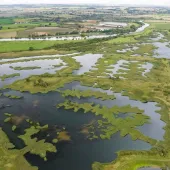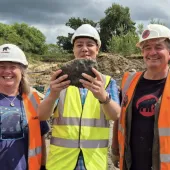Archaeology And Quarrying

Insights from the Magnesian Limestone Project
By Ian Roberts, Archaeological Services WYAS1
Mineral operators have long recognized the archaeological implications of their work and have striven to mitigate the impact of large-scale extractions. Initially, this was through arrangements within the Archaeological Code of Practice2 and statutory requirements for certain sites, but mainly, since 1990, as a consequence of Planning Policy Guidance Note (PPG) 16. Articulating with local UDPs and Minerals Local Plans, PPG16 has been responsible for a huge increase in archaeological investigations associated with mineral extraction. These investigations include preliminary assessments, prospecting for unknown sites using geophysical surveys, field walking and trial trenching, as well as final mitigation measures ranging from watching briefs to large-scale set-piece excavations. Naturally, all investigations were site specific, geared to satisfy planning requirements, and over the years this has resulted in the accumulation of a large data-set of information, but with no resources available to consider its implications for the broader overview. Thus, while sites were being detected and investigated, their significance in contributing to an improved global understanding of the archaeology was not being realized.
This was the background to the Magnesian Limestone Project, conceived in 2005 as a means of making greater sense of the large amount of archaeological data that had been created since 1990, on the Magnesian Limestone belt and the gravels, sandstones and coal measures along its margins. Because a large amount of the work had arisen through mineral operations, and because much of the future archaeological potential lay within areas of proposed and potential mineral extraction areas, it was possible to make a case for securing funding, via English Heritage, from the Aggregates Levy Sustainability Fund for a five-year project to map, collate, synthesize and publish conclusions about the rural archaeology over a wide area.
The project covered an area in excess of 1,500km2, centred on the Magnesian Limestone belt between Wetherby in the north and Dinnington in the south, focusing primarily upon the limestone, although areas of the adjacent geologies were included to provide a measure of comparison. In particular, the area of Sherwood Sandstone to the east was included, where a high level of quarrying has taken place in an area of very distinctive field systems. Consequently, although mainly within South and West Yorkshire, the study area also covers the adjacent margins of North Yorkshire and north Nottinghamshire.
Generally, the project aimed to provide a better insight into the nature of later prehistoric and Romano-British settlement and field systems, with a view to informing future research work in this region. Specifically, the purpose was to see if there were any spatial and chronological pattern and trends that might be equated with topography, geology and soils, or that might correspond to former cultural or territorial boundaries.
Methods
A major part of the project was the rectification and mapping of cropmarks from air photographs. Cropmarks form the most extensive landscape data-set and the thin soils of the limestone are particularly good at revealing ditches and other large cut archaeological features. However, in certain areas the geology, soil or agricultural regime (or a combination of these factors) has not been conducive to cropmark formation. A non-invasive method used to compensate for a lack of cropmark data, or indeed for enhancing and supplementing a cropmark record, is geophysical survey. This method has been used increasingly as a prospection tool for archaeological sites since 1990, and magnetomer surveys in particular have been used on a large scale to evaluate rural landscapes. Consequently, the project was able to draw upon a large amount of geophysical data.
Irrespective of how well a landscape is mapped by remote-sensing methods, archaeological sites are only better understood through excavation, and while such evidence forms the smallest data-set, it is obviously the most informative in determining the date and function of archaeological sites. All the various types of data have been entered on to a GIS database to aid the process of spatial and chronological analysis and synthesis. Full details of the project are due to be published in March 20103, and the following account merely offers a brief summary of the findings and conclusions by period.
Early prehistoric period
In terms of archaeological prospection, the detection of sites dating to before around 500BC has been problematic. Palaeolithic, Mesolithic and early Neolithic groups were transient and did not settle, while in the Bronze Age settlement boundaries and structures were formed by palisades and posts, the holes from which were essentially invisible to detection as cropmarks or by geophysical survey techniques. Consequently, such sites are only rarely encountered, usually when they coincide with areas of later, more visible settlement, or through serendipity in the wholesale stripping of large sites.
The only early prehistoric sites that show up as cropmarks and geophysical anomalies are ritual monuments, such as henges and barrows, due to them having been defined by deep ditches. There are also other forms of ritual and ceremonial monuments in the form of pit circles or single cremation or burial pits that can only be detected by excavation. Until relatively recently, the vast majority of known ritual monuments in the study area were ring barrows that formed satellites around the larger henges at Newton Kyme and Ferrybridge. Now, however, the results of wide-scale cropmark mapping and increased excavation have revealed a much wider distribution of barrows, particularly on the limestone where they are sometimes found in association with small henges or hengi-form monuments.
Iron Age
There are few demonstrable links between the archaeology of the early and later prehistoric periods. Ferrybridge Henge seems to have been abandoned in the late Bronze Age only to become the focus of later Iron Age settlement and ritual around 1,000 years later. Evidence for the late Bronze Age and early Iron Age is very scarce. This might be because the nature of the sites makes them difficult to detect them, but given the apparent long-term disuse of the henge at Ferrybridge, some wider-scale abandonment of the landscape might be implied.
The later Iron Age saw the adoption and development of settlement enclosures and extensive field systems, the former positions of which, because they were defined by large ditches, are clearly manifested in cropmarks and geophysical survey data. Consequently, these, and the developed complexes that subsequently evolved in the Roman period, form the largest data-set and have, therefore, been the sites most regularly targeted for archaeological excavation. Invariably, the enclosures and fields are rectangular in plan; the settlement enclosures often being denoted by the gullies of circular structures (roundhouses) that can equally reflect domestic dwellings, workshops or shrines. Certain variant forms of enclosure with extended entrances (aka ‘banjo enclosures’), possibly associated with livestock management, have been found in a cluster around South Kirkby, while another very distinct form involving conjoined agglomerated enclosures (perhaps a form of Iron Age village), has a limited distribution in the Aberford/Barwick area. The different identified forms of enclosure might be functional, but their limited distributions suggest that they may equally be cultural and relate to the sub-tribal nature of late Iron Age Yorkshire. Increased population, an economy highly geared to livestock and territoriality are some of the reasons that, it is supposed, lie behind the extensive adoption of ditched enclosures and field systems at this time.
On the limestone to the north of the river Don, field systems are more irregular in plan, while those on the flatter sandstone to the south of the Don often have very regular rectilinear plans, which have been likened to a ‘brickwork’ pattern. It has been concluded that, as well as flatter topography, a combination of greater prehistoric forest clearance facilitated the creation of these extensive regimented field systems in the late Iron Age. The biggest enigma, however, is the absence of any field systems in this period on the limestone south of the Don. Being slightly higher than the northern limestone, and seemingly short of watercourses, this area was probably marginal land for the early farmers who exploited the flatter, better-watered and more deforested sandstone areas to the east.
The Roman period
The project has been able to demonstrate that the Roman road network, established from about 70AD (when the Romans conquered Brigantia), cut straight through the existing Iron Age field systems. This phenomenon is probably a consequence of the new military roads taking the shortest routes between established river crossings, over the elevated well-drained areas. These were the very areas preferentially exploited by the Iron Age farmers and, although the roads were clearly constructed with little heed to the upheaval caused to the existing agricultural regimes, they were probably not a deliberate form of Roman subjugation. Remarkably, later field systems do not seem to have been reorientated to the new roads, although they did continue in use throughout the Roman period, the ditches often being re-cut on several occasions.
Evidence has also emerged for Roman military lines of communication along the major rivers in the form of two new forts; one at Roall on the river Aire to the east of Castleford, and another at Long Sandal on the river Don to the east of Doncaster. River traffic was probably used for heavy bulk materials and may well explain why excavations along the Roman road between Doncaster and Tadcaster have not revealed any evidence for intensive use by wheeled traffic, in the form of ruts.
The excavations of the last 20 years reveal that, for the vast majority of the indigenous Iron Age population in Yorkshire, the arrival of the Romans had very little impact on their way of life. Most native farmsteads seem to have continued with their subsistence farming, there being little evidence for changes in agricultural production or for a desire to adopt Roman culture. Only in the later 2nd century AD are their any signs of Romanization, with a greater incidence of Roman pottery and coins being found. Evidence for more ingrained Romanization is only really encountered in the 3rd and 4th centuries when there does seem to be a trend away from the small native-style farms with roundhouses to large estates with rectangular stone buildings, seemingly with a greater onus on arable farming, some being higher-status sites, such as villas.
Archaeology and quarrying
In the Magnesian Limestone study area alone, there are 56 contemporary extraction sites, 41 of which were active at the time of writing. Between 1990 and 2006 work on these sites resulted in 167 separate archaeological events, the vast majority of which involved excavation of one sort or another. This constitutes a very large portion of the rural archaeological data gathered within the study area. It is hoped that the greater understanding afforded by the Magnesian Limestone Project synthesis will allow more proactive assessments of the archaeological implications in future revisions of Local Minerals Plans and UDPs. The Yorkshire and Humber region is one of the major producers of aggregates in the UK, and the most recently published figures on primary aggregate reserves for this region, up to 2016, forecast a substantial deficit4. Consequently, aggregate minerals, in particular, will continue to be a major extraction industry in the study area.
Some will almost certainly regard the prospect of extensive future mineral extraction as a major threat to the nation’s archaeological heritage, there being few parts of the aggregate-bearing landscape that are devoid of archaeological sites or features. In the past, before archaeology was a material consideration, this might have been a legitimate concern. Now, however, archaeology as a result of mineral extraction must be regarded as well mitigated and a key agent in archaeological research. The presumption for preservation in situ, an underpinning tenet in archaeological good practice and guidance, must obviously hold sway when appropriate and practicable, but in many cases this is practical only if deep ploughing is curtailed to prevent archaeological erosion in situ. Indeed, many excavations have exposed a high level of unseen degradation of the cropmark landscape by repeated deep ploughing over the last 25–30 years. Some sites in areas of thinner soil, particularly on the limestone, which were well documented as cropmarks in the 1970s, are now found to have been eradicated or, at best, severely truncated, with only the bases of the deepest features now surviving.
Mineral extraction is, of course, just one of the means of obtaining archaeological data and some of the most important archaeological results in the study area have come from work carried out in advance of large linear projects, such as road schemes. But such undertakings are relatively infrequent events, perhaps only occurring in an area such as this once or twice in a generation. Mineral extraction, however, happens on a much larger scale and is effectively a continuous process. The archaeology associated with it, therefore, provides far better opportunities for formulating and testing research strategies relating to the past landscape over the short term, which for many cropmark sites, given agricultural erosion, is the time-scale we must now think in.
This article is based upon a lecture delivered to the North of England branch of the Institute of Quarrying in November 2009.
References
- Archaeological Services WYAS, PO Box 30, Nepshaw Lane South, Morley, Leeds LS27 0UG; iroberts@aswyas.com
- Confederation of British Industry, 1991, ‘Archaeological Investigations Code of Practice for Mineral Operators’.
- ROBERTS, I., with DEEGAN, A. and D. BERG: ‘Understanding the Cropmark Landscapes of the Magnesian Limestone. The archaeology of the Magnesian Limestone and its margins in South and West Yorkshire and parts of North Yorkshire and north Nottinghamshire’, 2010.
- BROWN, T.J., and D.E. HIGHLEY: ‘Primary Aggregate Reserves in England 1990–2004’, BGS Commissioned Report CR/06/168, 2006.








